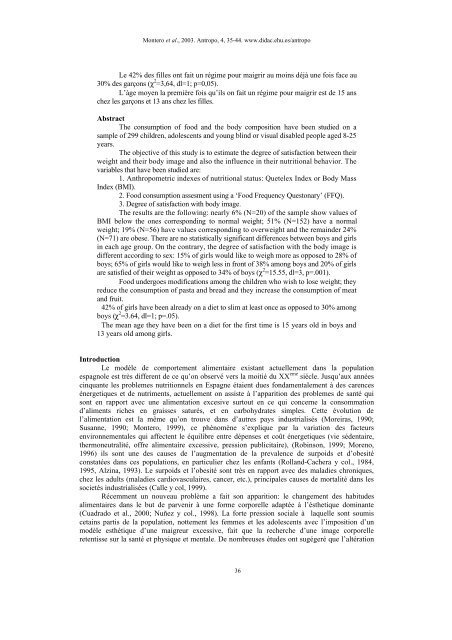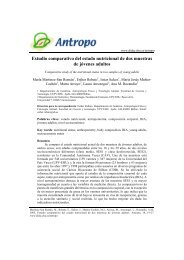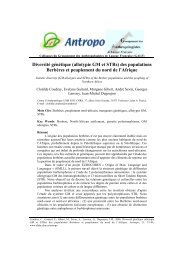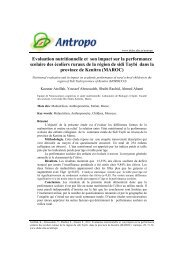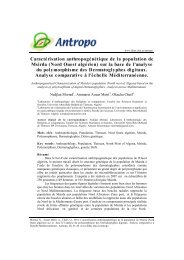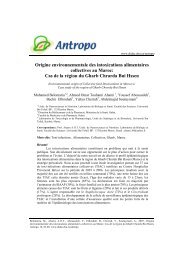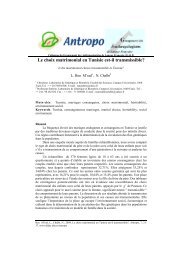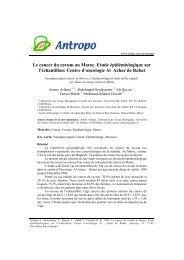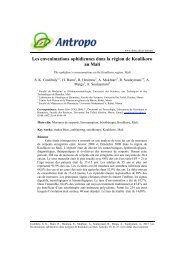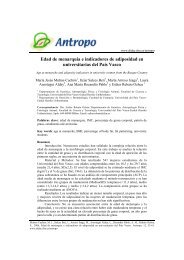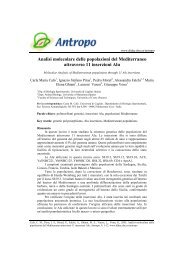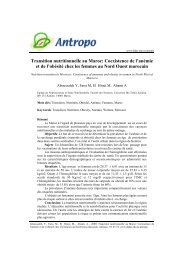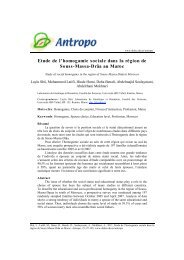Perception de l'image corporelle chez les enfants, les adolescents et ...
Perception de l'image corporelle chez les enfants, les adolescents et ...
Perception de l'image corporelle chez les enfants, les adolescents et ...
- No tags were found...
Create successful ePaper yourself
Turn your PDF publications into a flip-book with our unique Google optimized e-Paper software.
Montero <strong>et</strong> al., 2003. Antropo, 4, 35-44. www.didac.ehu.es/antropo<br />
Le 42% <strong>de</strong>s fil<strong>les</strong> ont fait un régime pour maigrir au moins déjà une fois face au<br />
30% <strong>de</strong>s garçons (χ 2 =3,64, dl=1; p=0,05).<br />
L’àge moyen la première fois qu’ils on fait un régime pour maigrir est <strong>de</strong> 15 ans<br />
<strong>chez</strong> <strong>les</strong> garçons <strong>et</strong> 13 ans <strong>chez</strong> <strong>les</strong> fil<strong>les</strong>.<br />
Abstract<br />
The consumption of food and the body composition have been studied on a<br />
sample of 299 children, ado<strong>les</strong>cents and young blind or visual disabled people aged 8-25<br />
years.<br />
The objective of this study is to estimate the <strong>de</strong>gree of satisfaction b<strong>et</strong>ween their<br />
weight and their body image and also the influence in their nutritional behavior. The<br />
variab<strong>les</strong> that have been studied are:<br />
1. Anthropom<strong>et</strong>ric in<strong>de</strong>xes of nutritional status: Qu<strong>et</strong>elex In<strong>de</strong>x or Body Mass<br />
In<strong>de</strong>x (BMI).<br />
2. Food consumption assesment using a ‘Food Frequency Questonary’ (FFQ).<br />
3. Degree of satisfaction with body image.<br />
The results are the following: nearly 6% (N=20) of the sample show values of<br />
BMI below the ones corresponding to normal weight; 51% (N=152) have a normal<br />
weight; 19% (N=56) have values corresponding to overweight and the remain<strong>de</strong>r 24%<br />
(N=71) are obese. There are no statistically significant differences b<strong>et</strong>ween boys and girls<br />
in each age group. On the contrary, the <strong>de</strong>gree of satisfaction with the body image is<br />
different according to sex: 15% of girls would like to weigh more as opposed to 28% of<br />
boys; 65% of girls would like to weigh <strong>les</strong>s in front of 38% among boys and 20% of girls<br />
are satisfied of their weight as opposed to 34% of boys (χ 2 =15.55, dl=3, p=.001).<br />
Food un<strong>de</strong>rgoes modifications among the children who wish to lose weight; they<br />
reduce the consumption of pasta and bread and they increase the consumption of meat<br />
and fruit.<br />
42% of girls have been already on a di<strong>et</strong> to slim at least once as opposed to 30% among<br />
boys (χ 2 =3.64, dl=1; p=.05).<br />
The mean age they have been on a di<strong>et</strong> for the first time is 15 years old in boys and<br />
13 years old among girls.<br />
Introduction<br />
Le modéle <strong>de</strong> comportement alimentaire existant actuellement dans la population<br />
espagnole est très different <strong>de</strong> ce qu’on observé vers la moitié du XX eme siécle. Jusqu’aux années<br />
cinquante <strong>les</strong> problemes nutritionnels en Espagne étaient dues fondamentalement à <strong>de</strong>s carences<br />
énerg<strong>et</strong>iques <strong>et</strong> <strong>de</strong> nutriments, actuellement on assiste à l’apparition <strong>de</strong>s problemes <strong>de</strong> santé qui<br />
sont en rapport avec une alimentation excesive surtout en ce qui concerne la consommation<br />
d’aliments riches en graisses saturés, <strong>et</strong> en carbohydrates simp<strong>les</strong>. C<strong>et</strong>te évolution <strong>de</strong><br />
l’alimentation est la même qu’on trouve dans d’autres pays industrialisés (Moreiras, 1990;<br />
Susanne, 1990; Montero, 1999), ce phénomène s’explique par la variation <strong>de</strong>s facteurs<br />
environnementa<strong>les</strong> qui affectent le équilibre entre dépenses <strong>et</strong> coût énerg<strong>et</strong>iques (vie sé<strong>de</strong>ntaire,<br />
thermoneutralité, offre alimentaire excessive, pression publicitaire), (Robinson, 1999; Moreno,<br />
1996) ils sont une <strong>de</strong>s causes <strong>de</strong> l’augmentation <strong>de</strong> la prevalence <strong>de</strong> surpoids <strong>et</strong> d’obesité<br />
constatées dans ces populations, en particulier <strong>chez</strong> <strong>les</strong> <strong>enfants</strong> (Rolland-Cachera y col., 1984,<br />
1995, Alzina, 1993). Le surpoids <strong>et</strong> l’obesité sont très en rapport avec <strong>de</strong>s maladies chroniques,<br />
<strong>chez</strong> <strong>les</strong> adults (maladies cardiovasculaires, cancer, <strong>et</strong>c.), principa<strong>les</strong> causes <strong>de</strong> mortalité dans <strong>les</strong><br />
soci<strong>et</strong>és industrialisées (Calle y col, 1999).<br />
Récemment un nouveau problème a fait son apparition: le changement <strong>de</strong>s habitu<strong>de</strong>s<br />
alimentaires dans le but <strong>de</strong> parvenir à une forme <strong>corporelle</strong> adaptée à l’ésth<strong>et</strong>ique dominante<br />
(Cuadrado <strong>et</strong> al., 2000; Nuñez y col., 1998). La forte pression sociale à laquelle sont soumis<br />
c<strong>et</strong>ains partis <strong>de</strong> la population, nottement <strong>les</strong> femmes <strong>et</strong> <strong>les</strong> ado<strong>les</strong>cents avec l’imposition d’un<br />
modèle esthétique d’une maigreur excessive, fait que la recherche d’une image <strong>corporelle</strong><br />
r<strong>et</strong>entisse sur la santé <strong>et</strong> physique <strong>et</strong> mentale. De nombreuses étu<strong>de</strong>s ont sugégeré que l’altération<br />
36


